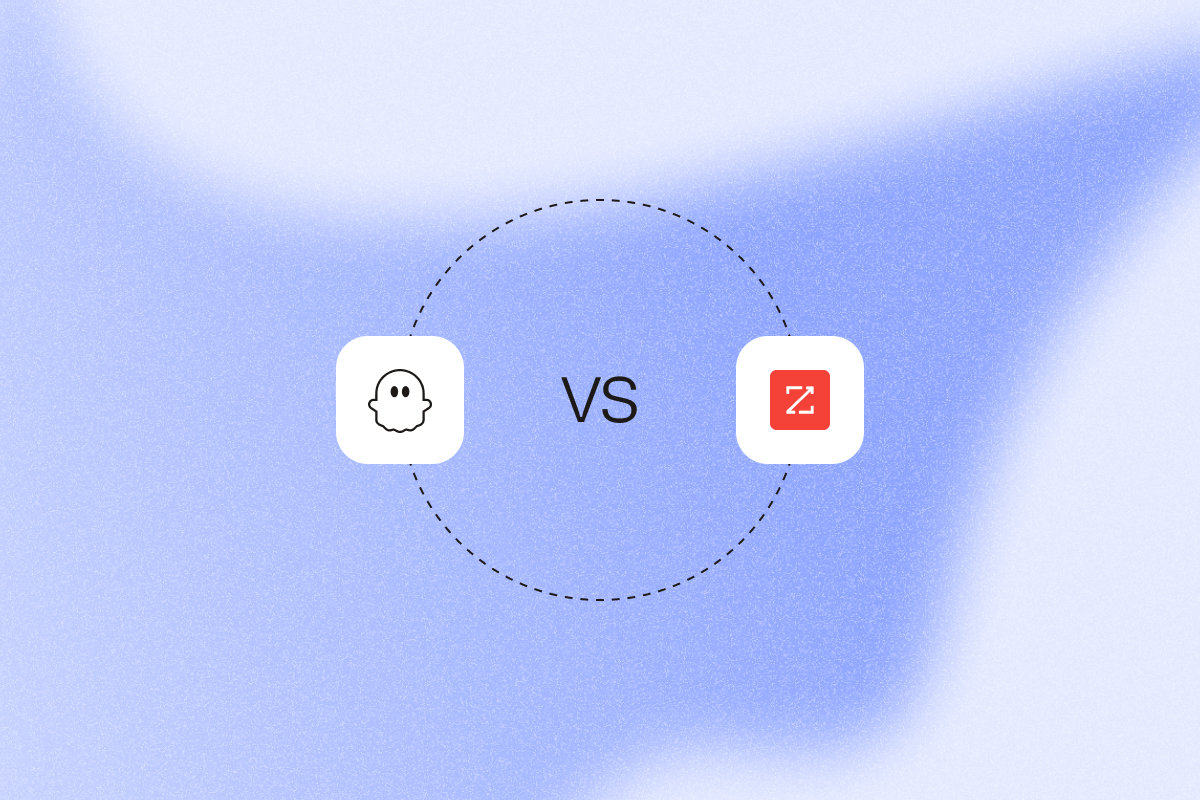Sales and marketing teams need accurate contact information to reach the right people. But which tools are best?
PhantomBuster is built for LinkedIn-first prospecting, with automation that extracts fresh, publicly available data and turns it into repeatable workflows. ZoomInfo follows a different path, offering a large database of verified contact information.
This detailed comparison puts both platforms to the test. You’ll then be able to weigh up which one best supports sales teams focused on LinkedIn.
PhantomBuster vs. ZoomInfo quick overview
| Category | PhantomBuster | ZoomInfo |
|---|---|---|
| Primary use case | Real-time LinkedIn prospecting: extract, enrich, automate outreach | Comprehensive database: verified contact data with intent signals |
| Target audience | Sales teams focused on LinkedIn automation and fresh data | Marketing and sales teams needing extensive database coverage |
| Ease of use | No-code automations, workflow automation, cloud execution | Advanced search filters, comprehensive contact information interface |
| Key features | LinkedIn automation, real-time data scraping, AI-powered data enrichment, custom workflows | Extensive database, intent data, buyer signals, CRM integration, anonymous website visitors |
| Pricing model | Usage-based subscription (shared workspace), transparent pricing | Credit-based system ($15,000-$40,000+ annually), custom pricing |
| G2 rating | 4.4/5 (100+ reviews) | 4.5/5 (12,000+ reviews) |
| Capterra rating | 4.5/5 (63 reviews) | 4.1/5 (311 reviews) |
PhantomBuster overview
PhantomBuster is an automation platform. It’s built for sales professionals who need real-time data extraction and LinkedIn workflows that scale.
Unlike other tools that rely on static databases that quickly become outdated, PhantomBuster collects fresh, publicly available data from LinkedIn profiles and other platforms.
PhantomBuster’s mission is to turn repetitive prospecting tasks into automated workflows. Sales teams can maintain accurate contact data, while running systematic LinkedIn outreach and engagement campaigns… without the manual lift.
Core features and capabilities
PhantomBuster delivers comprehensive automation across multiple data sources and social media platforms. Here’s a quick breakdown.
- Real-time data scraping: Extract current information directly from LinkedIn profiles, Sales Navigator searches, and company pages.
- LinkedIn automation workflows: Automate connection requests, follow-up sequences, and social warming activities while respecting platform guidelines and daily limits.
- Multi-platform data collection: Gather prospect data from LinkedIn, Sales Navigator, Google Maps, and other major platforms for comprehensive prospecting intelligence.
- AI-powered data enrichment: Find verified contact details using name and company information, with built-in validation to improve email deliverability and reduce bounce rates.
- Team coordination: Rotate multiple LinkedIn accounts safely across sales teams, and prevent duplicate outreach through advanced deduplication rules.
- CRM integration: Sync enriched prospect data directly with HubSpot, Salesforce, and other platforms through API access and webhook capabilities.
- Custom workflows: Connect automations to create sophisticated prospecting sequences for specific industries and target audiences.
We leverage PhantomBuster to strategically build and cultivate relationships with targeted personas for our B2B influencers. The platform enables us to precisely identify prospects by their LinkedIn job titles and roles, and then create personalized connection requests at scale. Our results speak volumes—acceptance rates that are 5-10x higher than other approaches. – Patrick Spencer, VP at Kiteworks“
Data compliance and ethical considerations
PhantomBuster prioritizes ethical automation practices, with comprehensive safety mechanisms built into every workflow. Here’s how it works.
- Human-like automation patterns: Schedule activities during business hours with randomized delays to mimic natural user behavior and avoid triggering platform restrictions.
- Account safety management: Distribute automation volume across multiple team accounts while respecting LinkedIn’s daily action limits and platform guidelines.
- Real-time data verification: Extract only publicly available information, maintaining GDPR compliance and ethical data collection standards.
- Technical expertise support: Provide clear guidance on automation limits and best practices, with automatic monitoring to prevent aggressive scraping methods.
- Workflow monitoring: Track all automated activities with detailed logs for compliance auditing and team oversight.
Nathan Guillaumin, PhantomBuster Product Expert:“When you launch automations, try always to be way lower than the limits—stay at 100 instead of targeting 150 (the limit). It will help you on the long run not to be flagged by LinkedIn.”
This approach enables users to scale LinkedIn prospecting while maintaining account integrity and following platform guidelines.
Who PhantomBuster is best for
PhantomBuster is a great fit if you:
- Need real-time prospect data
- Want fresh, accurate contact information
- Have marketing strategies that rely on current information
- Want to automate existing workflows, without needing extensive technical knowledge
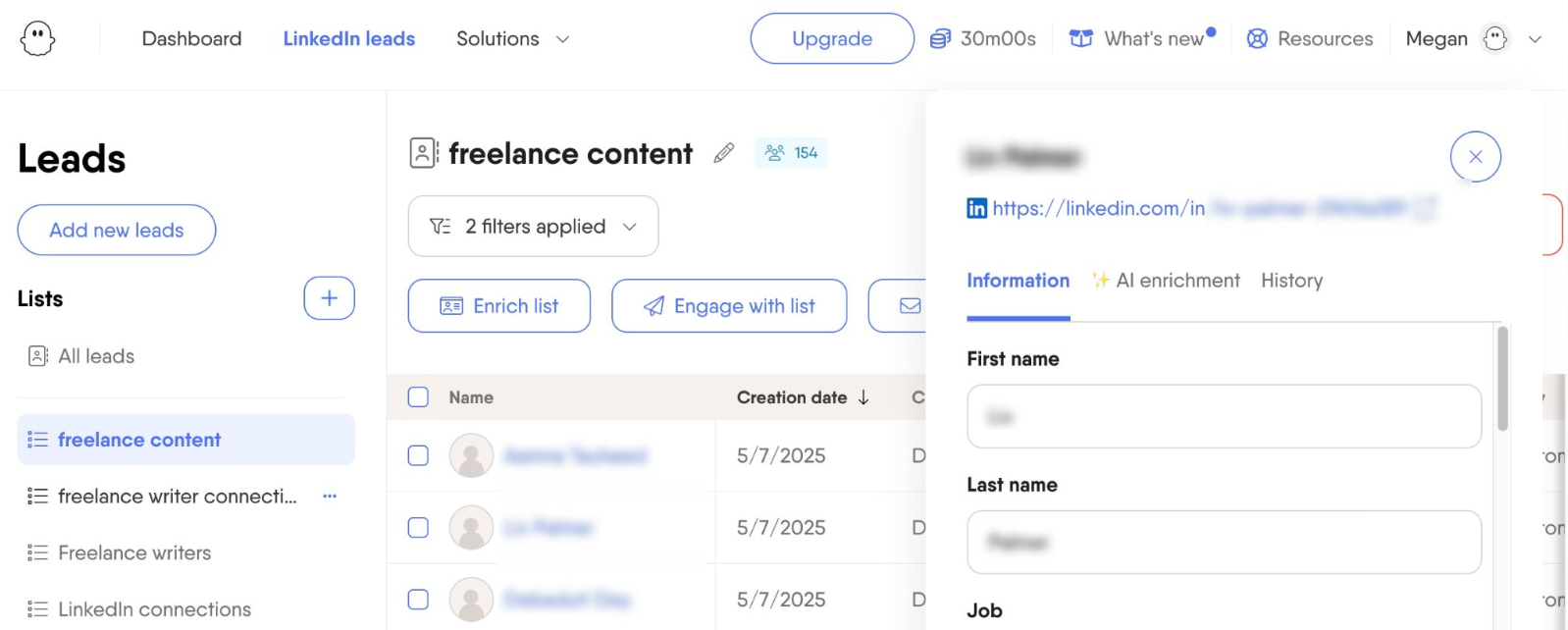
Pricing summary
PhantomBuster uses transparent pricing with workspace-based subscriptions starting at $56/month (annual billing).
All pricing plans include complete feature access, with differences in execution time, AI credits, and concurrent automation capacity. The platform offers a 14-day free trial with full functionality and no credit card requirements.
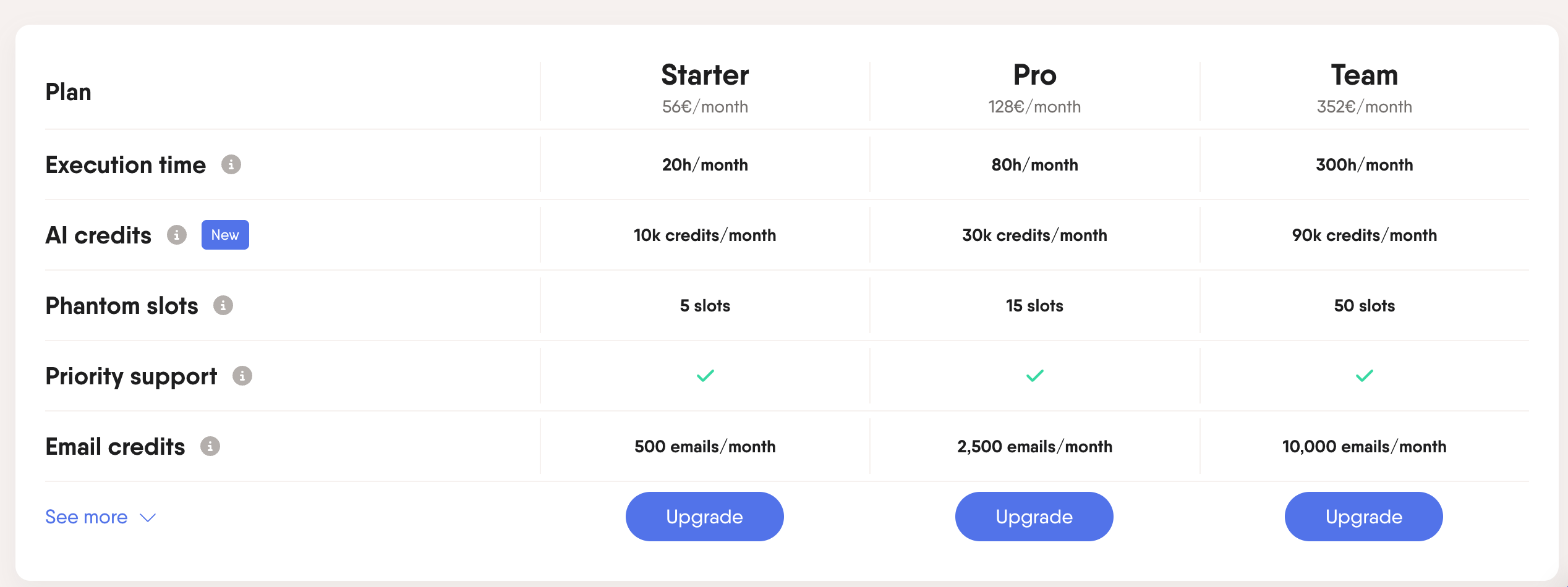
ZoomInfo overview
ZoomInfo is a go-to-market intelligence platform centered on its large database of verified contact data and company information. Instead of pulling data in real time, it maintains a curated repository of business contacts supported by enrichment tools.
It’s positioned as an all-in-one solution for prospect identification, intent data, and workflow automation. This is useful for teams that need wide market coverage and detailed company insights.
Core features and capabilities
ZoomInfo’s core features revolve around its database and add-on intelligence tools. Here’s an overview.
- Extensive database: Access a large database with 320M+ contacts and 100M+ companies, including verified phone numbers.
- Intent data and buyer signals: Track intent data to spot buying signals and prioritize outreach.
- Advanced search filters: Use detailed criteria, such as by revenue, employee count, tech stack, and location.
- Anonymous website visitors: Identify companies visiting your website and connect them with verified contact details for immediate follow-up.
- Integration capabilities: Sync with major CRM platforms, marketing tools, and sales platforms.
Data compliance and ethical considerations
ZoomInfo manages data compliance in the following ways:
- Data verification processes: Maintains accuracy through multiple data sources, user contributions, and regular validation cycles.
- GDPR framework: Provides compliance tools and opt-out mechanisms for European markets and privacy regulation adherence.
- Database governance: Handles data sourcing transparency and consent management on behalf of platform users.
The database approach shifts data collection responsibilities to ZoomInfo while requiring users to ensure proper consent and compliance for their outreach activities.
Feature-by-feature analysis of PhantomBuster vs. ZoomInfo
These platforms represent different philosophies. While PhantomBuster centers on real-time LinkedIn automation, ZoomInfo offers broad database coverage with added intelligence features. Let’s compare them.
LinkedIn automation and scalability
LinkedIn is still the core channel for B2B prospecting, so automation makes the difference in how fast teams can scale.
- PhantomBuster: Works as a dedicated LinkedIn automation engine with workflows for connection requests, messaging, social warming, and multi-account rotation. Teams can schedule outreach during business hours, avoid overlap, and stay within safe limits across accounts.
- ZoomInfo: Offers Sales Navigator integration for list building but no built-in automation for connection requests, messaging, or relationship building.
Result: PhantomBuster delivers complete LinkedIn automation workflows.On the other hand,ZoomInfo serves more as a prospect identification and data enrichment platform requiring external automation tools.
Prospecting and data quality
Accurate, up-to-date prospect data is the foundation of effective outreach.
- PhantomBuster: Pulls data in real time from LinkedIn profiles and Sales Navigator, with built-in email discovery and verification to keep contact details current and reduce bounce rates.
- ZoomInfo: Delivers verified contact information from its large database, but updates may lag behind real-world job or company changes.
Result: PhantomBuster ensures high-quality data through real-time extraction, while ZoomInfo offers broad verified coverage that can be less immediate.
Data enrichment
Enrichment turns basic contact details into the insights that make outreach personal and timely.
- PhantomBuster: Offers real-time data enrichment, combining LinkedIn profile updates with company info, job changes, and engagement signals. Email discovery is built in, giving teams valuable insights for outreach.
- ZoomInfo: Adds depth through its database, offering verified phone numbers, detailed company data, intent signals, and market insights for account-based strategies.
Result: PhantomBuster delivers behavioral insights tied to real-time activity, while ZoomInfo provides broad enrichment powered by its database and intelligence tools.
Integrations
Strong integrations make it easier to move contact data into existing sales and marketing workflows.
- PhantomBuster: Connects with HubSpot, Salesforce, Google Sheets, and offers API access plus unlimited exports. This lets teams add automation and real-time data extraction without disrupting their stack.
- ZoomInfo: Integrates broadly with major CRMs, marketing tools, and sales engagement platforms, emphasizing large-scale data sync across enterprise systems.
Result: PhantomBuster delivers flexible, lightweight integrations, while ZoomInfo focuses on deep connectivity within complex enterprise stacks.
Pricing and value
Pricing often decides whether a tool can scale with the team… or block it.
- PhantomBuster: Starts at $56 per month with workspace-based subscriptions. No per-user fees, predictable costs, and capacity that can be shared across teams.
- ZoomInfo: Runs on credit-based contracts that typically cost $15,000–$40,000+ per year. Pricing depends on features, seats, and credits, with long-term commitments common.
Result: PhantomBuster offers transparent, affordable pricing that scales with growth. On the other hand, ZoomInfo requires a large enterprise budget and custom contracts, with exact pricing plans available on request.
Pros and cons of PhantomBuster vs. ZoomInfo
PhantomBuster is built for real-time automation and LinkedIn-first workflows, while ZoomInfo emphasizes database size and enterprise features.
PhantomBuster
PhantomBuster gives sales teams fresh data, complete LinkedIn automation, and transparent pricing. It does require an understanding of safe automation practices, but once set up, it delivers strong gains in accuracy and productivity.
| ✅ Pros | ❌ Cons |
|---|---|
| Real-time data extraction and freshness | Requires knowledge of automation best practices |
| Complete LinkedIn automation workflows | Limited to publicly available data sources |
| Transparent pricing with shared resources | Bound by LinkedIn’s platform limitations |
| Multi-platform prospecting capabilities | – |
| Flexible integration with existing workflows | – |
| Plug into HubSpot/Salesforce so reps work from up-to-date records, not spreadsheets | – |
ZoomInfo
ZoomInfo offers extensive database coverage and advanced intelligence features, making it a fit for enterprise teams that need broad market reach and detailed prospect analysis.
However, the trade-off is high cost, contract complexity, and data that may not always reflect real-time changes.
| ✅ Pros | ❌ Cons |
|---|---|
| Large database with broad coverage | High cost with enterprise-level pricing |
| Advanced features like intent data and buyer signals | No transparent pricing structure |
| Strong verification for contact accuracy | Records may lag behind real-world changes |
| Anonymous website visitor identification | Credit-based limits on data access |
| Detailed company intelligence and market insights | Complex features that require training |
Use case scenarios for PhantomBuster vs. ZoomInfo
Real-world scenarios show how each platform handles common prospecting challenges across different team needs. Let’s look at each of these tools in action.
Scenario 1: Building targeted prospect lists for quarterly sales campaigns
The challenge: A B2B software company needs 3,000 qualified prospects for a Q1 campaign, with accurate contacts and coordinated outreach.
- PhantomBuster: Automates list building from LinkedIn Sales Navigator, adds real-time email discovery and company data, and runs social warming to lift connection rates. Data flows straight into the CRM with team safeguards to avoid overlap.
- ZoomInfo: Uses advanced filters and intent data to identify prospects and provide verified contact details, but relies on external tools for outreach automation.
Result: PhantomBuster delivers end-to-end campaign automation with fresh data, while ZoomInfo offers broad identification and targeting insights.
Scenario 2: Enterprise account-based marketing with intent data
The challenge: A marketing team needs to spot in-market accounts and coordinate multi-channel outreach across SDRs.
- PhantomBuster: Tracks LinkedIn engagement and job changes to surface intent signals, but is geared toward individual prospect automation rather than full account intelligence.
- ZoomInfo: Delivers intent data, buyer signals, and website visitor tracking to give a fuller view of account activity and support ABM strategies.
Result: ZoomInfo leads on enterprise-level account intelligence, while PhantomBuster focuses on real-time signals at the individual prospect level.
Scenario 3: Scaling prospecting operations for growing sales teams
The challenge: A sales org is expanding from 8 to 25 SDRs and needs consistent workflows that scale without breaking the budget.
- PhantomBuster: Uses a shared workspace model with no per-user fees. Account rotation and deduplication prevent overlap, while safe limits keep multi-account outreach compliant. This makes scaling cost-effective.
- ZoomInfo: Expands through credits and user licenses, so costs rise steeply as team size grows.
Result: PhantomBuster enables predictable, affordable team scaling, while ZoomInfo’s model ties costs directly to headcount and usage.
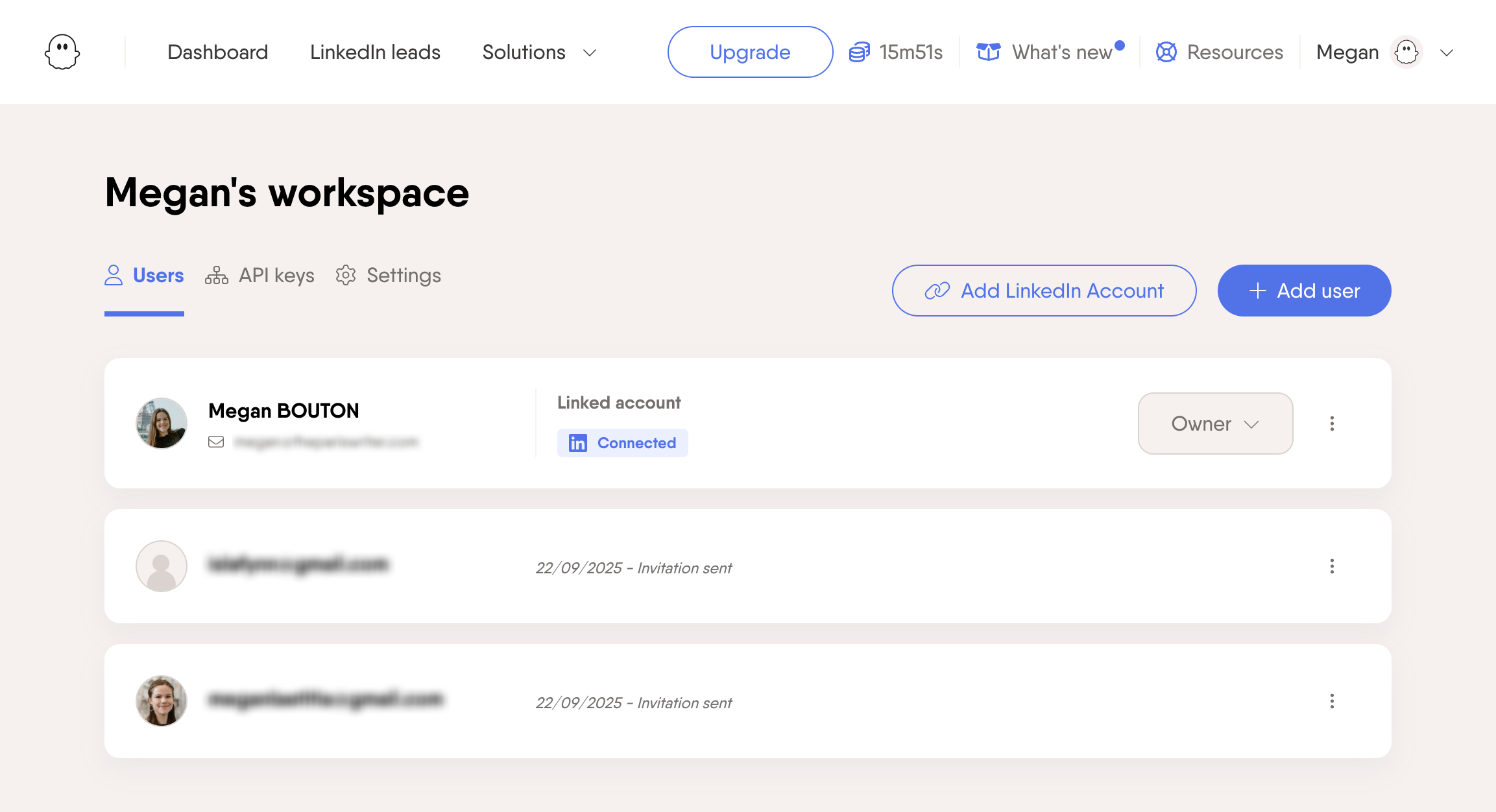
Expert opinions and user reviews on PhantomBuster vs. ZoomInfo
PhantomBuster
“PhantomBuster makes it easy to automate repetitive tasks that would otherwise take hours. I primarily use it for LinkedIn prospecting, scraping, and outreach workflows, and it saves significant time while maintaining accuracy.
“Overall, it gives me a big productivity boost and helps scale campaigns quickly without requiring advanced technical skills.
“The learning curve can feel steep at first, especially if you’re new to automation tools. Some Phantoms require fine-tuning or trial-and-error to get running smoothly, which can be frustrating.” — Anonymous G2 reviewer
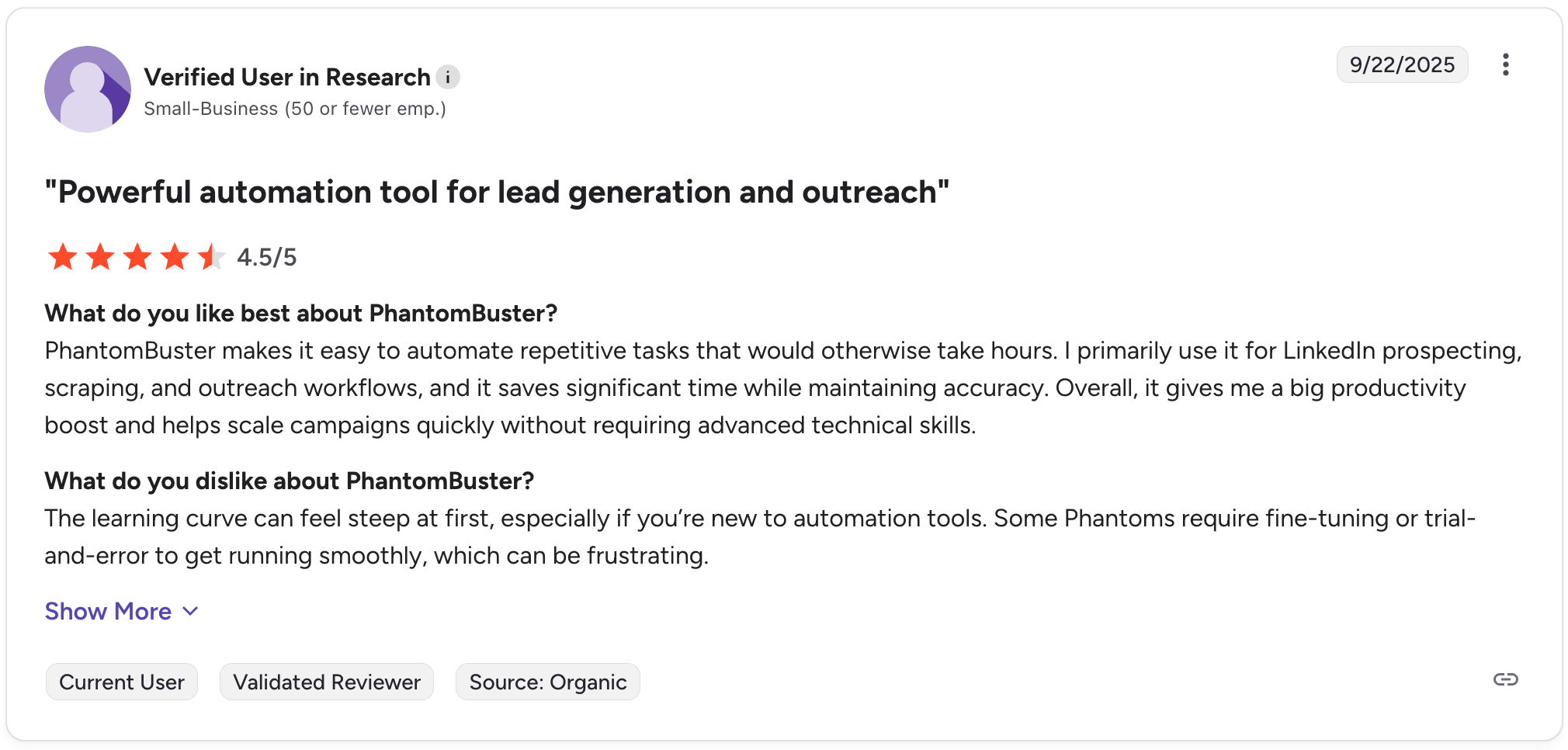
“What I appreciate most about PhantomBuster is how intuitive and user-friendly it is. The UI/UX is clean and easy to navigate, even for first-time users. Setting up automations takes just a few clicks, and the platform does a great job guiding you through the process.
“We primarily use it for LinkedIn outreach and data scraping, and it has significantly reduced the time we spend on manual tasks. I also love the detailed reports that show how much time has been saved over the month – it’s a small feature, but one that adds a lot of value.
“One downside of PhantomBuster is the limited customizability of its automations. While it offers a wide range of pre-built Phantoms, there’s not much room to tweak or personalize them beyond what’s already configured…” — Lance E. (Digital Marketing Manager, Small-Business)
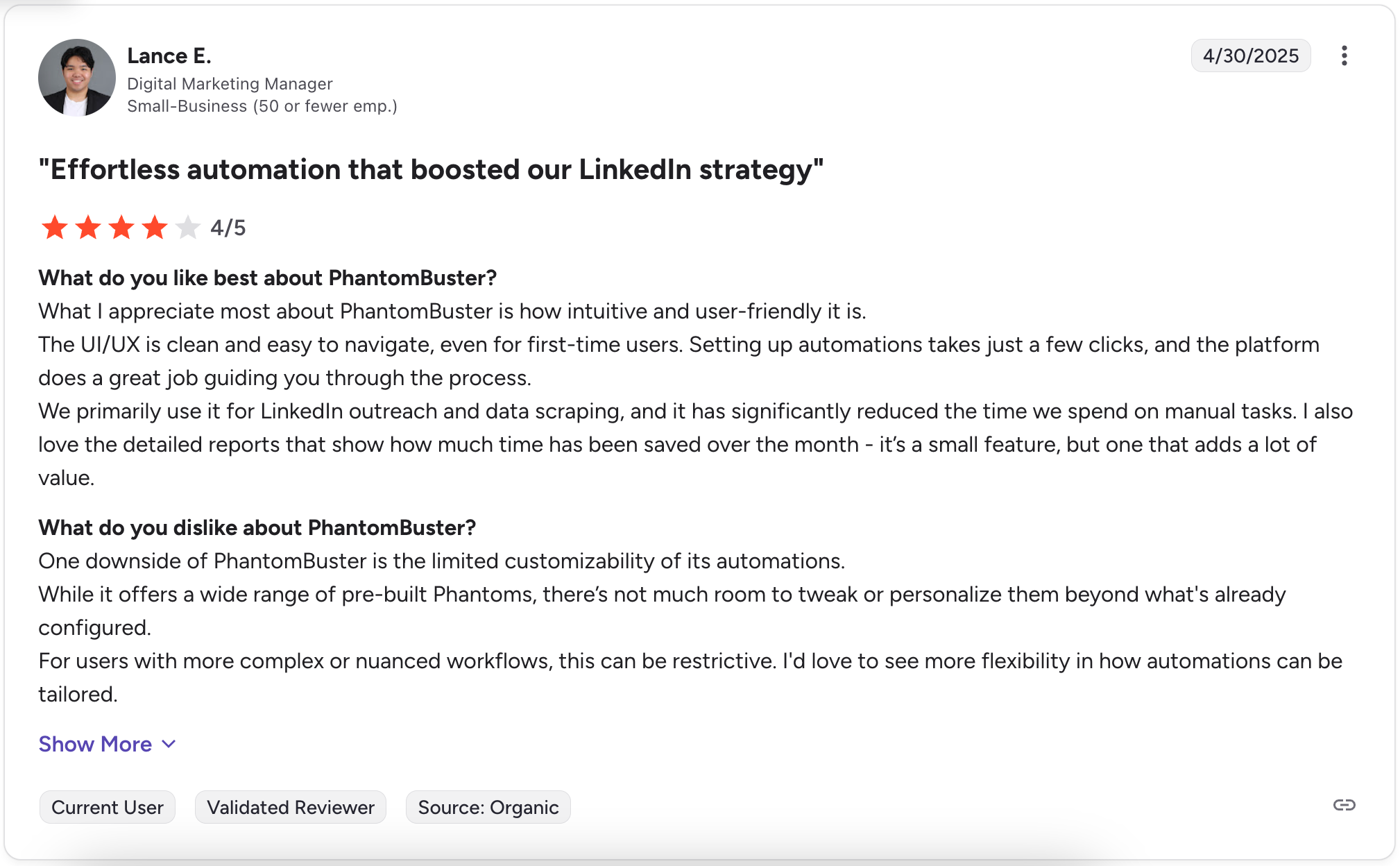
ZoomInfo
“ZoomInfo database saves me time and effort in finding potential leads. Helps by reaching the right people with the right message. While ZoomInfo data is generally reliable, occasionally inaccuracies or outdated information hinder sales efforts.” — Kia S. (SDR, Mid-Market)
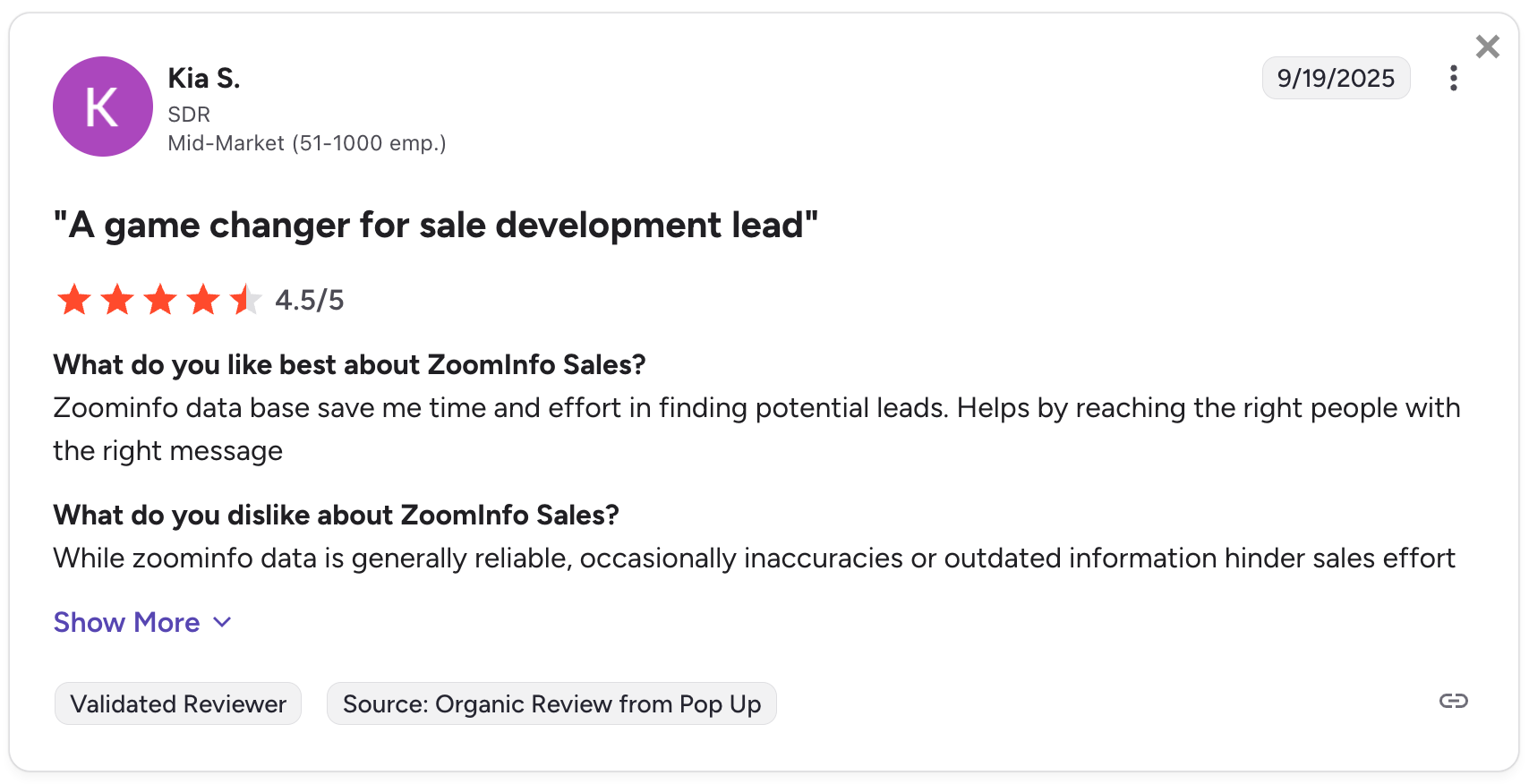
“Ease of use, nice UI experience, good admin tools and easy to control. Major downside is cost. It’s an expensive tool compared to others in the market.” — Jamie B. (Sales Enablement, Mid-Market)
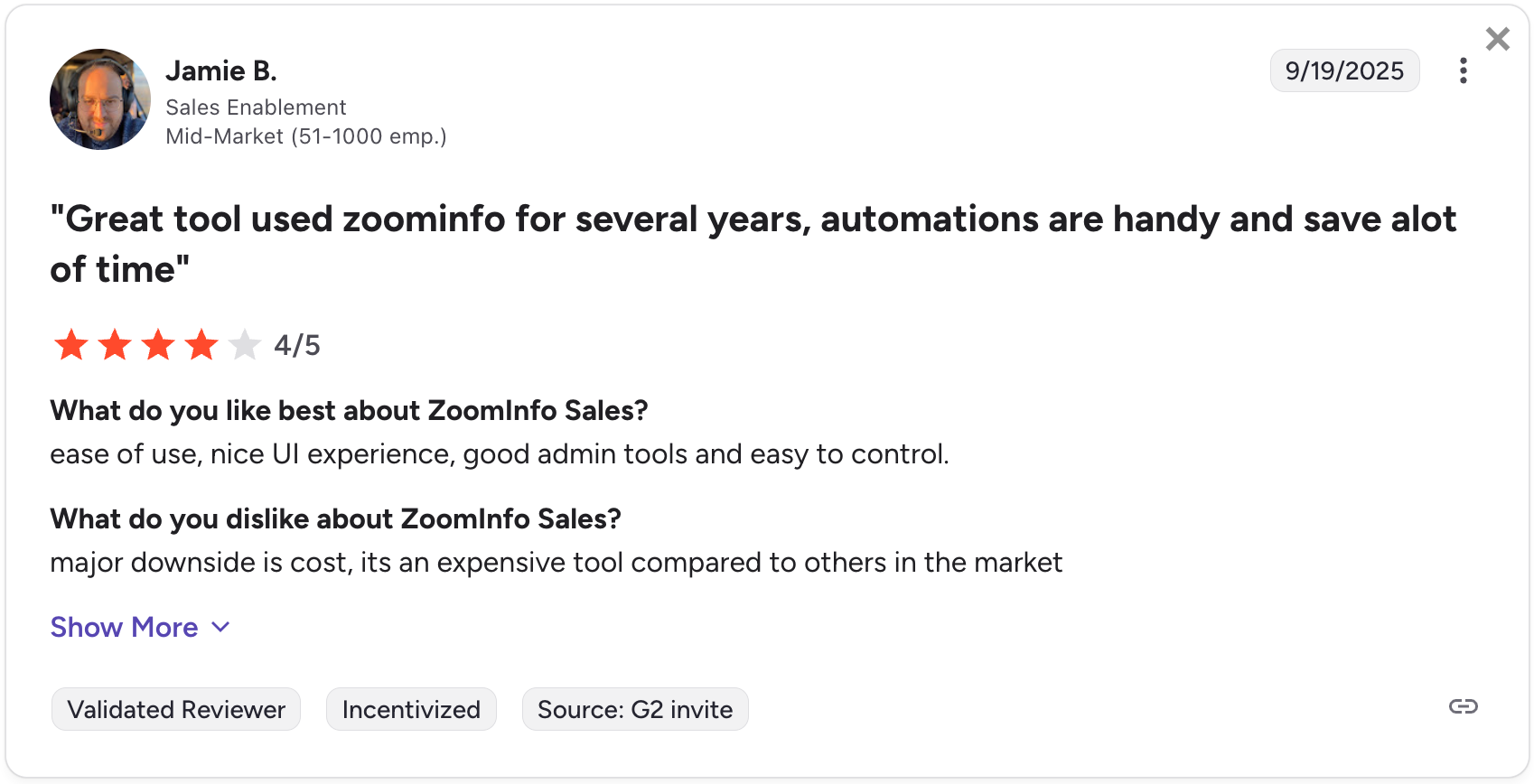
User sentiment analysis: Users value PhantomBuster for saving time on LinkedIn prospecting and outreach, with many praising its ease of use and clean interface. The main drawbacks are a learning curve for newcomers and limited customization of pre-built automations.
ZoomInfo, on the other hand, earns strong marks for its broad database and reliable lead access, but users consistently flag outdated records and high costs as key frustrations.
Final verdict on PhantomBuster vs. ZoomInfo
PhantomBuster and ZoomInfo both solve contact data challenges, but they serve different needs.
- Choose PhantomBuster for real-time LinkedIn automation, fresh data, transparent pricing, and lead generation workflows that scale without per-user costs.
- Choose ZoomInfo for broad database coverage, advanced intelligence features, and intent data (if you have the enterprise budget to support it).
In short, PhantomBuster prioritizes automation and data freshness, while ZoomInfo offers depth through its database and intelligence tools.
Frequently asked questions about PhantomBuster vs. ZoomInfo
How does PhantomBuster ensure data accuracy compared to ZoomInfo’s database approach?
PhantomBuster delivers accuracy by extracting data in real time from LinkedIn profiles and Sales Navigator, so job changes and company updates are reflected immediately.
As PhantomBuster Product Expert Nathan Guillaumin notes: “The best will be to use Sales Navigator as the searches are always more precise. You can combine other filters—people who have changed jobs lately, people who posted on LinkedIn, filter based on geography—many things you cannot do on a simple LinkedIn search.”
Can PhantomBuster replace ZoomInfo for comprehensive market intelligence?
Not directly. PhantomBuster focuses on real-time LinkedIn automation and fresh data extraction, while ZoomInfo delivers database intelligence with intent signals and buyer insights.
Some teams pair them, using PhantomBuster for prospecting workflows and ZoomInfo for broader market research.
Which platform offers better value for growing sales teams?
PhantomBuster offers stronger value with its shared workspace model, as teams can add users without extra per-seat fees while sharing automation capacity. ZoomInfo ties pricing to credits and licenses, so costs rise quickly as headcount grows.
How do the LinkedIn automation capabilities compare?
ZoomInfo focuses on identification and database intelligence, not automation. PhantomBuster covers full LinkedIn automation, including connection requests, messaging, social warming, and multi-account rotation.
As Nathan Guillaumin explains: “I’ve been helping users launch flows with social warming actions and noticing a big switch in results—from 10% acceptance rates to up to 50% because you’ve sufficiently warmed up your leads.”
Which platform better supports compliance and platform guidelines?
Both platforms prioritize compliance in different ways. PhantomBuster embeds safety into its workflows, with built-in limits and guidance for ethical LinkedIn automation.
ZoomInfo manages compliance at the database level through verification processes and opt-out options for contact records.
Does ZoomInfo offer real-time data extraction like PhantomBuster?
No. ZoomInfo relies on database updates and verification cycles, not live extraction.
PhantomBuster specializes in real-time data collection from LinkedIn and other platforms, so information reflects immediate job and market changes.
How do the integration capabilities differ between platforms?
PhantomBuster offers flexible integrations like API access, CRM sync, and Google Sheets exports, making it easy to slot into existing workflows.
ZoomInfo emphasizes enterprise-level connectivity, with deep CRM and marketing automation integrations designed for large sales stacks.
Which platform requires more technical expertise to implement effectively?
PhantomBuster needs some knowledge of automation best practices and LinkedIn guidelines, though its interface is designed to stay user-friendly. “You need to see automation as a time saver and not something magical,” Nathan Guillaumin explains.
ZoomInfo also involves a learning curve, especially for advanced features, but provides enterprise support and account management.
